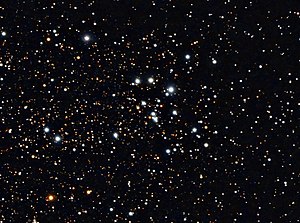Open cluster in the constellation Sagittarius
Messier 18 or M18 , also designated NGC 6613 and sometimes known as the Black Swan Cluster , is an open cluster of stars in the constellation Sagittarius . It was discovered by Charles Messier in 1764 and included in his list of comet -like objects.[ 8] Earth , M18 is situated between the Omega Nebula (M17) and the Small Sagittarius Star Cloud (M24).[ 3]
This is a sparse[ 9] [ 5] tidal radius of 7.3 pc,[ 6] [ 10] Trumpler class of II 3 p .[ 4] [ 6] M ☉ [ 5] Be star and 29 B-type stars in total.[ 9] supergiant stars , all of class A or earlier .[ 11] HD 168352, is a B-type giant star with a class of B2 III and a visual magnitude of 8.65.[ 4]
Messier 18 is 1,296 kpc[ 2] Galactic Center .[ 5] eccentricity of 0.02. This carries it to as close as 6.5 kpc to, and as far as 6.8 kpc from the galactic core. It passes vertically through the galactic plane once every 27.4 million years, ranging no more than 80 pc above or below.[ 1]
As of January 2022, Messier 18 is one of the few remaining objects within the Messier Catalog to not have been photographed by the Hubble Space Telescope . [ 12]
Gallery
See also
References
^ a b c Wu, Zhen-Yu; et al. (November 2009), "The orbits of open clusters in the Galaxy", Monthly Notices of the Royal Astronomical Society 399 (4): 2146– 2164, arXiv :0909.3737 Bibcode :2009MNRAS.399.2146W , doi :10.1111/j.1365-2966.2009.15416.x S2CID 6066790 . ^ a b Kharchenko, N. V.; et al. (2005), "Astrophysical parameters of Galactic open clusters", Astronomy and Astrophysics , 438 (3): 1163– 1173, arXiv :astro-ph/0501674 Bibcode :2005A&A...438.1163K , doi :10.1051/0004-6361:20042523 , S2CID 9079873 . ^ a b Frommert, Hartmut; Kronberg, Christine (August 21, 2007), Messier 18 , retrieved 2018-11-11 . ^ a b c Lindoff, U. (December 1971), "The open clusters NGC 6613 (M 18) and NGC 6716", Astronomy and Astrophysics , 15 : 439– 449, Bibcode :1971A&A....15..439L . ^ a b c d e Joshi, Y. C.; et al. (October 2016), "Study of open clusters within 1.8 kpc and understanding the Galactic structure", Astronomy & Astrophysics , 593 : 13, arXiv :1606.06425 Bibcode :2016A&A...593A.116J , doi :10.1051/0004-6361/201628944 , S2CID 118610932 , A116. ^ a b c Piskunov, A. E.; et al. (January 2008), "Tidal radii and masses of open clusters", Astronomy and Astrophysics , 477 (1): 165– 172, Bibcode :2008A&A...477..165P , doi :10.1051/0004-6361:20078525 ^ "M 18" . SIMBAD Centre de données astronomiques de Strasbourg . Retrieved November 11, 2018 .^ Adam, Len (2018), Imaging the Messier Objects Remotely from Your Laptop 117– 120, Bibcode :2018imor.book.....A , ISBN 978-3319653853 ^ a b McSwain, M. Virginia; Gies, Douglas R. (November 2005), "The Evolutionary Status of Be Stars: Results from a Photometric Study of Southern Open Clusters", The Astrophysical Journal Supplement Series , 161 (1): 118– 146, arXiv :astro-ph/0505032 Bibcode :2005ApJS..161..118M , doi :10.1086/432757 , S2CID 14498164 . ^ Santos-Silva, T.; Gregorio-Hetem, J. (November 6, 2012), "Characterisation of young stellar clusters", Astronomy & Astrophysics , 547 : A107, arXiv :1209.1585 Bibcode :2012A&A...547A.107S , doi :10.1051/0004-6361/201219695 , S2CID 119213441 . ^ Eggenberger, P.; et al. (May 2002), "The blue to red supergiant ratio in young clusters at various metallicities", Astronomy and Astrophysics , 386 (2): 576– 582, arXiv :astro-ph/0202478 Bibcode :2002A&A...386..576E , doi :10.1051/0004-6361:20020262 , S2CID 14373322 . ^ "Explore - the Night Sky | Hubble's Messier Catalog" . 28 August 2017.^ "Stellar Lab in Sagittarius" , www.eso.org , retrieved 11 August 2016 .
External links
Wikimedia Commons has media related to
Messier 18 .




